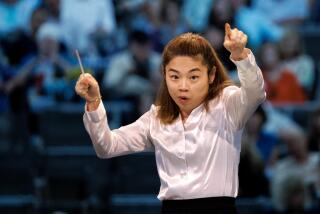Ascending Conductor, Enduring Violinist Debut at Bowl
The Los Angeles Philharmonic continued to show off its bench strength Thursday night with the Hollywood Bowl debut of assistant conductor Kristjan Jarvi, 27, the bearer of a bona fide brand name familiar to compulsive collectors of classical recordings. His father is Neeme Jarvi, the prolific conductor who seems bent upon recording the entire Schwann catalog; his older brother is Paavo Jarvi, first sighted right here at the late Philharmonic Institute and currently carving out a big-league conducting career of his own.
For a historical parallel among orchestra leaders, think about Josef Strauss trying to follow his father, Johann Sr., and his older brother, Johann Jr. Well, Josef did all right, and it would appear that Kristjan has a plentiful supply of his family’s musical genes as well.
Apparently the younger Jarvi is intensely interested in contemporary music, but there was none of that on display in a night of standard 19th century classics geared for Bowl audiences. At first, he seemed rather cautious in the mercurial Overture to Smetana’s “The Bartered Bride,” keeping the perpetual-motion string passages together yet generating little drive, fire and hardly any lightness of texture.
Now in her mid-70s, Polish-born violinist Ida Haendel has been active professionally since 1937--indeed, Haendel recordings dating back over a half-century were being offered at the CD booths outside the Bowl--but she had never appeared at the Bowl until Thursday. Early in the first movement of the Brahms Violin Concerto, there were distress signals--lapses in pitch, some laborious rhetoric. Yet before long, she was able to sustain a virtually seamless long lyrical line, with gradual tempo fluctuations and lingering suspense--and eventually most of the technical problems fell away. Jarvi and the Philharmonic were able to faithfully follow Haendel’s path, though with only minimal amounts of warmth in the first two movements and gypsy lilt in the Finale.
It was in Mendelssohn’s “Italian” Symphony that Jarvi was really able to shine--swaying back and forth, generating a clear beat, and holding the attention of the Philharmonic in a vigorous, brightly lit performance. He could produce thrust in the phrasing of the first movement, establish a flowing elegance in the third movement with some nicely placed portamentos in the strings, and the concluding Saltarello had sufficient energy and excellent staccato playing from the winds.
More to Read
The biggest entertainment stories
Get our big stories about Hollywood, film, television, music, arts, culture and more right in your inbox as soon as they publish.
You may occasionally receive promotional content from the Los Angeles Times.










